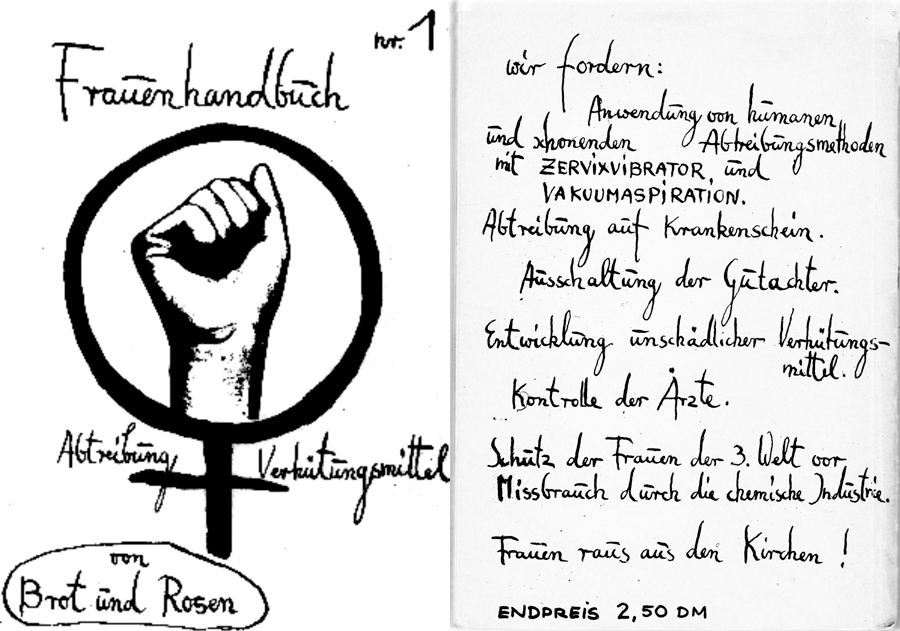Elitist and effective
Some descriptions of the beginnings of the new women’s movement in Berlin give the false impression that one group developed out of another, for example the women’s center out of Bread and Roses.
The head of Bread and Roses was Helke Sander. Having initiated the alternative nursery school (Kinderladen) movement and the Action Council to free Women, which however disbanded in 1969 over ideological differences, she turned to the issue of contraception. In 1971 she gathered a few women who then jointly wrote and self-published Frauenhandbuch Nr. 1: Abtreibung und Verhütungsmittel, a handbook on abortion and contraceptive devices. In 1972, she made the witty and at the time highly interesting documentary about the birth control pill, Macht die Pille frei? together with Sarah Schumann and camerawoman Gisela Tuchtenhagen.[i]
In 1971 Helke Sander began doing research on the effects of the Pill in collaboration with painter Sarah Schumann and Verena Stefan—the author of the 1975 Shedding, which at 500,000 copies sold to date is the most-read novel of the new women’s movement. Helke Sander recalls:
First we interviewed twenty doctors about the effects of the Pill, but not one of them could tell us anything concrete. So we began to do our own research. Verena Stefan was a physiotherapist in those days and she was together with doctor, whom we interviewed. She [Verena] found the questions so interesting that she wanted to work with us. Then two other painters joined the group: Evelyn Kuwertz and Antonia Wernery. Yes, most of us were artists! Some were or became lesbians. I had already been sterilized, so the topic did not actually affect us personally. We simply wanted to think through a few things! Finding and understanding the research papers on the Pill was not easy—the Internet didn’t exist—it was laborious but effective.
The manufacturers tested the Pill on Puerto Rican women, for example, and on men who had come into contact with estrogen during the production process and had grown breasts. The Vatican invested in the factories, by the way!
I had already taken the Pill in the 1960s, as a sort of guinea pig, and suffered from cardiac pain—at the time I attributed it to my bad marriage—in fact there was too much estrogen in the pills, many women died. These pills were eventually banned.
That is why we also opposed the call by Frigga Haug and the SFB for “the Pill on demand.” We thought that safe contraceptives needed to be developed first.
The first edition of Frauenhandbuch Nr. 1 had a print run of 30,000. There was a room full of these books on Klausenerplatz. We gave them to the bookshops but never received any records of sales. The first edition was yellow, followed two years later, in 1974, by an edition in red.
We knew nothing about the American group Our Bodies, Ourselves, who put out their book in 1971 out of the same motivations, with the same outcome. In 1974 Bread and Roses organized a big event at the TU where we issued a complaint against doctors who performed illegal abortions—particularly one of them who was nicknamed “The Golden Curette,” but was officially strictly opposed to abortion. Another was over 80 and half-blind, but continued to perform abortions—a bunch of scandalous physicians. Although it was a criminal offense, our complaint was never pursued.

The ink on the Handbuch was scarcely dry when the group Bread and Roses was deluged with requests from affected women. All members of the group had jobs and some of them had children. Thus it was impossible for them to keep up with the demand for counseling personally, as Esther Dayan told me in an interview: “Thank God for the women’s center.” The women’s center offered weekly abortion counseling, alternately provided by Bread and Roses and the Center’s abortion rights group.
This division into qualified authorship and grassroots information and counseling work was no coincidence, however. Roswitha Burgard was in contact with Bread and Roses, but then joined the women’s center. Looking back in conversation she explained why:
The leading women were 10 or 20 years older than I was and wanted to stay in their small group, I can understand that now. But I wanted to do something with women, not for women. That is why I switched to the women’s center when it was founded. At the women’s center in those days we tried not to cultivate the individual anymore, while Helke was a prominent and well-known personality because of her films. We, in contrast, wanted to do everything collectively—until the point when that didn’t work anymore. That was the difference as I see it.
[i] The 1972 film “Macht die Pille frei?” (Does the Pill Set Us Free?) is distributed today by Studio Hamburg.
